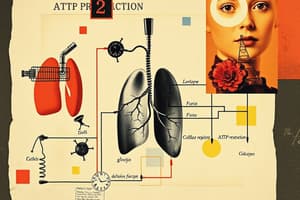Podcast
Questions and Answers
Cellular Respiration begins with?
Cellular Respiration begins with?
- Oxygen
- ATP
- Glucose (correct)
- Carbon Dioxide
Glucose is broken down during?
Glucose is broken down during?
glycolysis
Glycolysis produces a net gain of?
Glycolysis produces a net gain of?
2 ATP
Glycolysis occurs in the?
Glycolysis occurs in the?
Glycolysis produces?
Glycolysis produces?
Pyruvic acid can be used in anaerobic processes only.
Pyruvic acid can be used in anaerobic processes only.
Give an example of anaerobic processes.
Give an example of anaerobic processes.
Fermentation produces?
Fermentation produces?
Pyruvic acid can only be used in aerobic processes.
Pyruvic acid can only be used in aerobic processes.
Aerobic respiration starts with?
Aerobic respiration starts with?
Citric acid cycle occurs in the?
Citric acid cycle occurs in the?
Citric acid cycle has a net yield of?
Citric acid cycle has a net yield of?
Citric acid cycle produces?
Citric acid cycle produces?
All the products of the Citric acid cycle are used in the?
All the products of the Citric acid cycle are used in the?
Electron transport chain makes?
Electron transport chain makes?
Electron transport chain occurs in the?
Electron transport chain occurs in the?
Flashcards are hidden until you start studying
Study Notes
Cellular Respiration Overview
- Begins with glucose, the primary energy source for cellular processes.
- Involves multiple stages, including glycolysis, the citric acid cycle, and the electron transport chain.
Glycolysis
- Occurs in the cytoplasm of the cell.
- Breaks down glucose to produce 2 pyruvic acids.
- Results in a net gain of 2 ATP molecules.
- Can function under both aerobic and anaerobic conditions.
Anaerobic Processes
- An example is fermentation, which occurs when oxygen is not available.
- Fermentation converts pyruvic acid into lactic acid, resulting from anaerobic respiration.
Aerobic Respiration
- Begins with the citric acid cycle, which utilizes acetyl CoA.
- Takes place in the mitochondria, the powerhouse of the cell.
- Produces a net yield of 2 ATP, along with 6 NADH and 2 FADH2 molecules.
- Releases 2 CO2 molecules as waste products.
Electron Transport Chain
- The products of the citric acid cycle are utilized here.
- Situated in the mitochondria and responsible for generating a significant amount of ATP, approximately 34 ATP molecules.
Studying That Suits You
Use AI to generate personalized quizzes and flashcards to suit your learning preferences.




